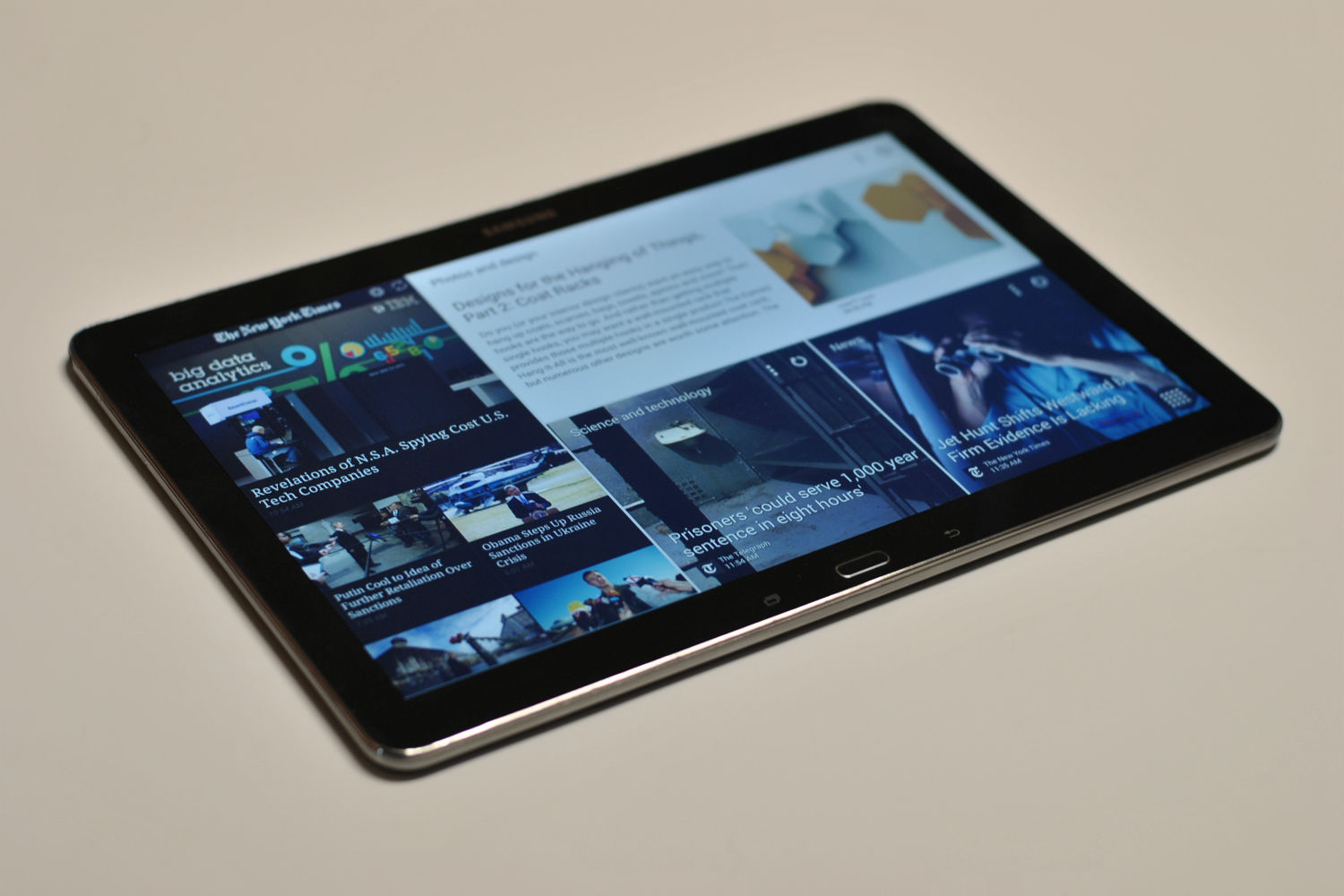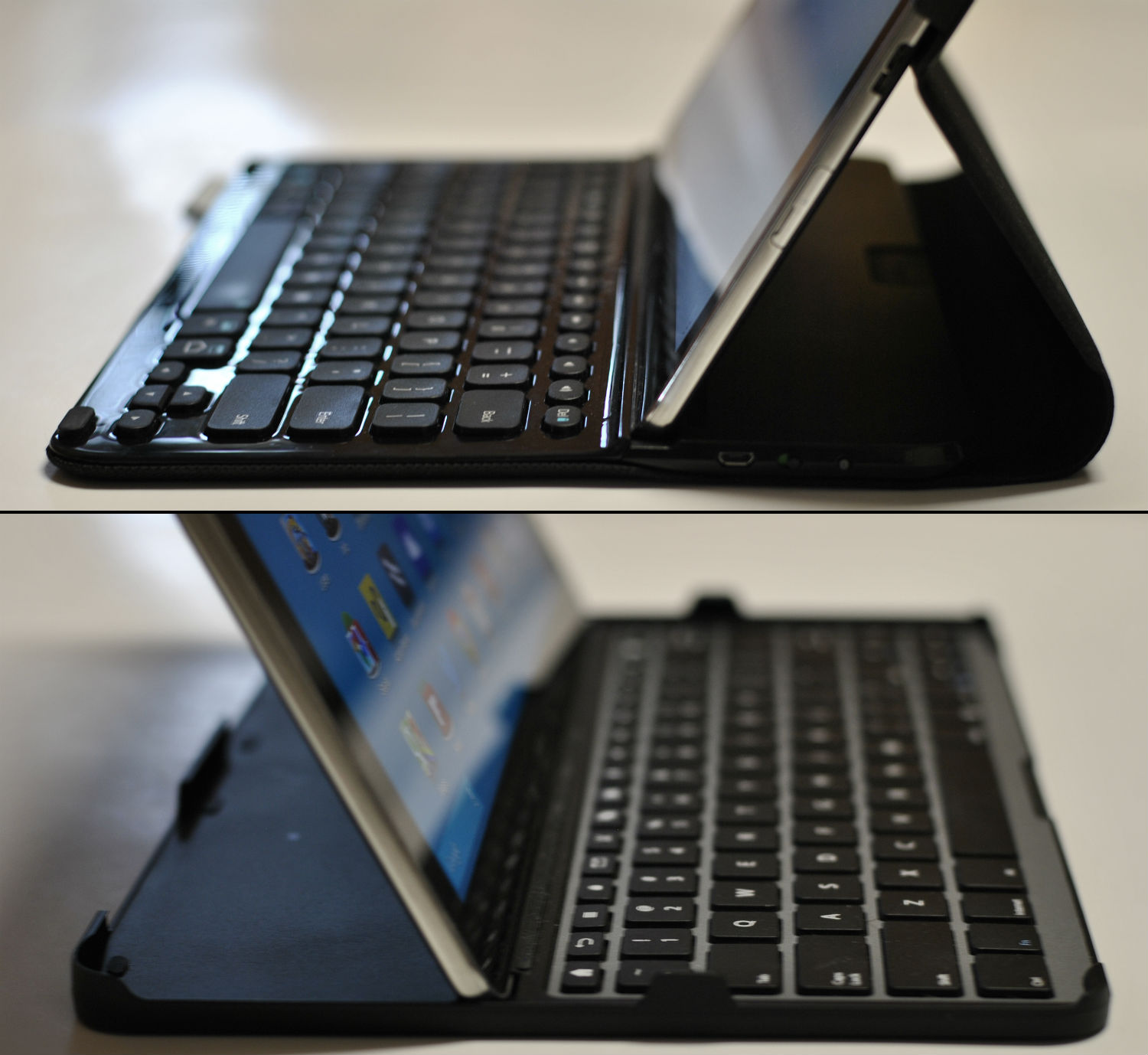
There must be an unspoken rule that Android tablets shall not exceed 10 inches in screen size. Few tablets have dared to go larger, and the rare exceptions have been forgettable.
But Samsung’s Galaxy Note Pro stands out. It has a 12.2-inch, 2560-by-1600 resolution display, includes an active digitizer stylus and lets you run up to four apps on the screen simultaneously. The implication — especially given the name — is that you can use it for work.
I was excited to give it try, even though my past attempts with Android haven’t gone so well. With a review unit supplied by Samsung and a couple of third-party Bluetooth keyboards, I put the Galaxy Note Pro to work.
It went okay — better than expected, even — but while I generally enjoyed using the Galaxy Note Pro, a couple of errors and omissions hold it back.
Work, for me, involves reading and researching on the Internet, taking notes, writing in a document editor, building stories in WordPress and occasionally creating basic spreadsheets. There isn’t any particular program I need that doesn’t exist on Android, it’s just a matter of how well I can perform my usual tasks.
The Galaxy Note Pro’s “Multi Window” feature was a huge help in that regard. While putting together our comparison of cloud storage services, I had Chrome open on half of the screen, while splitting the other half between OfficeSuite and our group chat service, HipChat (using a different browser for the latter). On smaller Galaxy devices, Samsung doesn’t allow more than two Multi Window apps at once, but opening it up to four apps makes sense for the Note Pro’s larger display. I always felt like I had enough space to work comfortably, and I was working in a way that isn’t possible on other Android tablets or Apple’s iPad.
Still, for multitasking or referencing two apps at once, Multi Window isn’t as well-done as Snap view in Windows 8. Many Android apps don’t support Multi Window, and things don’t always work as you’d expect. For example, tapping a link in Twitter while you have Chrome open causes the browser to go full-screen, removing Twitter from view. The feature is still useful overall, but it could be better.

Not all of Samsung’s software features are as well thought-out as Multi Window. The most egregious among them is the “Magazine UX,” a separate home screen for exclusive Samsung widgets. Each of these widgets — for things like Flipboard, the New York Times and Samsung’s own Calendar and Mail apps — resemble large tiles, forming a grid. It’s basically a more stylized version of the widget system that Android already offers, but the number of supported apps is much smaller.
I’d say there’s no good reason to use Magazine UX — except you don’t have a choice. Samsung requires you to dedicate at least one screen to Magazine UX, with at least one widget on the screen. That’s madness.
I’m also not convinced that Samsung’s “S Pen” stylus features have transcended gimmick status. Do people really have a strong desire to draw on top of screenshots or lasso little bits of the screen into a digital scrapbook? And why would I take out the pen just to draw a little window in which to open another app, when I can perform the same task more easily with my fingers? Many of these features seem helpful in theory, but never become necessary in real-world use.

That’s not to say the stylus is useless. It’s obviously great for drawing, and it’s helpful for dealing with websites that are designed for a mouse or trackpad, because you can hover over screen elements just like a cursor. But Samsung’s built-in software doesn’t really help with these tasks. The one thing I really wanted to do with the S Pen — use the entire screen like a big sheet of paper for writing down ideas — required me to grab a third-party app from the Google Play store. (Correction: I somehow missed the S-Note app, which does allow for full-screen note-taking.)
Performance used to be an issue for getting work done on tablets, but the Note Pro was zippy enough for my needs. I often juggled lots of browser tabs at once, and was able to use the full version of WordPress’s website to write for Time.com. When I wasn’t working, I’d kick back with a few rounds of Beach Buggy Blitz, and it ran as smoothly as I’ve ever seen it. The Note Pro’s 1.9-GHz quad-core processor and 3 GB of RAM is about as good as it gets on a tablet, and I was able to make it through an entire workday with a Bluetooth keyboard attached.
There only performance problems I noticed were on the home screen, which was prone to choppiness and didn’t always register my taps on the first try. Again, I wonder if Samsung’s bloated home screen software is to blame.
As for the feel of the Note Pro, it’s reasonably light for its size at 1.6 pounds. I didn’t feel like the screen was too big to use comfortably, though it is more conducive to landscape mode than portrait mode. My only gripe is that the plastic chassis feels a bit flimsy, betraying Samsung’s “Pro” branding.
The Case for a Built-In Keyboard

One really nice thing about the Galaxy Note Pro is that it pairs nicely with a full-sized keyboard. Along with the Galaxy Note Pro, I tried a couple of Bluetooth keyboards made specifically for Samsung’s large tablet. Zagg’s Cover Fit ($100, pictured on bottom) is a slim keyboard stand with a groove in the middle that props the tablet up. You can also easily snap the tablet into the case, face-down, for easy travel. Logitech’s Pro Keyboard ($130, pictured on top) is a folio-style cover that clasps into the top half of the tablet so you can fold it closed with the screen facing up or down.
I liked both keyboards for different reasons. Zagg’s keyboard is good for occasional use because you can just plop the tablet into the stand and pull it back out again with no fuss, but the keys are thin and don’t offer much travel. Logitech’s thicker keys feel better to type on, but leaving the tablet attached makes for a much bulkier contraption, and pulling the tablet apart takes more effort. It’s a better option if you want a physical keyboard handy most of the time.
Neither option would be as good as an integrated keyboard, like the one Microsoft offers for its Surface tablets. Pairing a keyboard over Bluetooth can be a pain, and if you want to go back to using just the touchscreen, you can’t simply detach the keyboard. You must either turn off the keyboard or turn off the tablet’s Bluetooth connection.
For a professional tablet, especially of this size, I would have loved a built-in, full-sized keyboard with a physical connection. Apple is rumored to be working on a larger tablet with its own integrated keyboard, so I don’t get why Samsung skipped this element if it’s trying to beat Apple to market with the Note Pro.
If you need a tablet that’s ready for work, you’ve got a few options. Apple’s iPad is a fine all-around option, with the best selection of apps and a huge number of Bluetooth keyboards to choose from, but not being able to open more than one app at a time is a big drawback. Windows-based tablets such as Microsoft’s Surface 2 are on the other end of the spectrum: They run Office and are better at multitasking than iOS or Android, but the selection of touch-optimized apps is the weakest.
Samsung’s Galaxy Note Pro occupies a middle ground. The selection of tablet apps is better than Windows, but weaker than iOS, but being able to reference two or more apps at the same time can be a great boost to productivity — especially on the extra-large screen. Still, the Note Pro is an expensive option, starting at $750 with 32 GB of storage, not including a keyboard. (If you can live without the stylus, Samsung’s Galaxy Tab Pro 12.2 is $100 cheaper, and is identical aside from the missing S Pen.)
So who’s the Note Pro for? It may work best for someone who’s comfortable leaving the laptop behind, but still wants something that’s a little more laptop-like than an iPad. I just wish Samsung had made more effort to appeal to that niche.
More Must-Reads From TIME
- What Student Photojournalists Saw at the Campus Protests
- How Far Trump Would Go
- Why Maternity Care Is Underpaid
- Saving Seconds Is Better Than Hours
- Welcome to the Golden Age of Ryan Gosling
- Scientists Are Finding Out Just How Toxic Your Stuff Is
- The 100 Most Influential People of 2024
- Want Weekly Recs on What to Watch, Read, and More? Sign Up for Worth Your Time
Contact us at letters@time.com